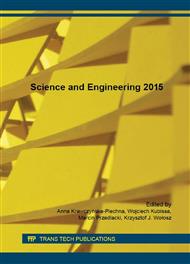[1]
L. Czarnecki, Nanotechnology in civil engineering (in Polish), Przegląd Budowlany 1 (2011) 40-53.
Google Scholar
[2]
N. Stankiewicz, M. Lelusz, Nanotechnology in civil engineering - application review (in Polish), Civil and environmental engineering 5 (2014) 101-112.
Google Scholar
[3]
T. Błaszczyński, B. Gwozdowski, Introduction to nanotechnology problems (in Polish), Izolacje 2 (2013) 38-42.
Google Scholar
[4]
L. Hui, X. Hui-Gang, Y. Jie, O. Jin-ping, Microstructure of cement mortar with nano-particles, Composites: Part B 35 (2004) 185-189.
Google Scholar
[5]
N. Abdoli Yazdi, M.R. Arefi, E. Mollaahmadi, B. Abdollahi Nejand, To study the effect of adding Fe2O3 nanoparticles on the morphology properties and microstructure of cement mortar, Life Science Journal 8/4 (2011) 550-554.
Google Scholar
[6]
A. Nazari, S. Riahi, Effect of TiO2 on properties of self-compacting concrete (in Polish), Cement Wapno Beton 3 (2011) 167-181.
DOI: 10.32047/cwb.2021.26.2.1
Google Scholar
[7]
A. Nazari, S. Riahi, The effects of ZnO2 nanoparticles on properties of concrete using ground granulated blast furnace slag as binder, Materials Research 14/3 (2011) 299-306.
DOI: 10.1590/s1516-14392011005000052
Google Scholar
[8]
A. Nazari, Computer-aided prediction of physical properties of high-strength concrete containing Fe2O3 nanoparticles (in Polish), Cement Wapno Beton 5 (2012) 265-285.
Google Scholar
[9]
A. Nazari, S. Riahi, S.F. Shamekhi, A. Khademno, Influence of Al2O3 nanoparticles on the compressive strength and workability of blended concrete, Journal of American Science 6(5) (2010) 6-9.
Google Scholar
[10]
A. Nazari, S. Riahi, Effects of CuO nanoparticles on compressive strength of self-compacting concrete, Sadhana 36/3 (2011) 371-391.
DOI: 10.1007/s12046-011-0023-7
Google Scholar
[11]
I. Flores, K. Sobolev, L. M. Torres-Martinez, E. L. Cuellar, P. L. Valdez, E. Zarazua, Performance of cement systems with nano-SiO2 particles produced by using the sol-gel method, Transportation Research Record 2141 (2010) 10-14.
DOI: 10.3141/2141-03
Google Scholar
[12]
A. Nazari, S. Riahi, The effects of Cr2O3 nanoparticles on strength assessments and water permeability of concrete in different curing media, Materials Science and Engineering: A 528/3 (2011) 1173-1182.
DOI: 10.1016/j.msea.2010.09.099
Google Scholar
[13]
A. Nazari, S. Riahi, Abrasion resistance of concrete containing SiO2 and Al2O3 nanoparticles in different curing media, Energy and Buildings 43 (2011) 2939-2946.
DOI: 10.1016/j.enbuild.2011.07.022
Google Scholar
[14]
P. Niewiadomski, A Short overview of the effects of nanoparticles on the mechanical properties of concrete, Key Engineering Materials 662 (2015) 257-260.
DOI: 10.4028/www.scientific.net/kem.662.257
Google Scholar
[15]
M. F. Doerner, W. D. Nix, A method for interpreting the data from depth-sensing indentation instruments, Journal of Material Research 1(4) (1986) 601-609.
DOI: 10.1557/jmr.1986.0601
Google Scholar
[16]
W. C. Oliver, G. M. Pharr, An improved technique for determining hardness and elastic modulus using load and displacement sensing indentation experiments, Journal of Material Research 7(6) (1992) 1564-1583.
DOI: 10.1557/jmr.1992.1564
Google Scholar
[17]
G. L. Golewski, Fracture processes in concrete containing siliceous fly ash additives, Politechnika Lubelska, Lublin, 2015, 232-248.
Google Scholar
[18]
L. Sorelli, G. Constantinides, F. -J. Ulm, F. Toutlemonde, The nano-mechanical signature of ultra high performance concrete by statistical nanoindentation techniques, Cement and Concrete Research 38 (2008) 1447-1456.
DOI: 10.1016/j.cemconres.2008.09.002
Google Scholar
[19]
J. -D. Han, G. -H. Pan, W. Sun, C. -H. Wang, D. Cui, Application of nanoindentation to investigate chemomechanical properties change of cement paste in the carbonation reaction, Sci China Tech Sci 55 (2012) 616-622.
DOI: 10.1007/s11431-011-4571-1
Google Scholar
[20]
G. Constantinides, F. -J. Ulm, The effect of two types of C-S-H on the elasticity of cement-based materials: results from nanoindentation and micromechanical modelling, Cement and Concrete Research 34 (2004) 67-80.
DOI: 10.1016/s0008-8846(03)00230-8
Google Scholar
[21]
J. J. Gaitero, I. Campillo, P. Mondal, S.P. Shah, Small Changes Can Make a Great Difference, Transportation Research Record 2141 (2010) 1-5.
DOI: 10.3141/2141-01
Google Scholar
[22]
P. Mondal, S. P. Shah, L. D. Marks, J. J. Gaitero, Comparative study of the effects of microsilica and nanosilica in concrete, Transportation Research Record 2141 (2010) 6-9.
DOI: 10.3141/2141-02
Google Scholar
[23]
P. Mondal, S. P. Shah, L. D. Marks, A reliable technique to determine the local mechanical properties at the nanoscale for cementitious materials, Cement and Concrete Research 37 (2007) 1440-1444.
DOI: 10.1016/j.cemconres.2007.07.001
Google Scholar
[24]
P. Mondal, S. P. Shah, L. D. Marks, Nanoscale characterization of cementitious materials, Materials Journal 105(2) (2008) 174-179.
Google Scholar
[25]
J. J. Gaitero, I. Campillo, A. Guerrero, Reduction of the calcium leaching rate of cement paste by addition of silica nanoparticles, Cement and Concrete Research 38 (2008) 1112-1118.
DOI: 10.1016/j.cemconres.2008.03.021
Google Scholar


